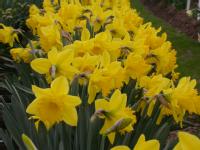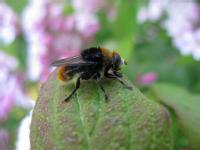Narcissus (daffodil)
The UK is the world leader in the commercial production of daffodils, with over 4,000ha grown. Nearly half of the output of bulbs and cut-flowers is exported to Europe and North America. Over half of this area is concentrated in south Lincolnshire and Norfolk in eastern England, where Spalding is a major hub for the fresh produce industry. There is also a major daffodil-growing area in West Cornwall and a significant area in the Grampians, so successive crops harvested from these geographical areas provide continuity over a long production season. Specialised aspects of daffodil growing include the production of early-flowering, scented ‘tazetta’ narcissi on the Isles of Scilly, and growing daffodils for the extraction of the anti-dementia drug galantamine (galanthamine).
The UK narcissus industry is estimated to have an annual output value of around £45million, but forms part of a much larger industry involving the import, export and packaging of a huge range of flower-bulbs, bulb flowers and bulb plants both wholesale and retail.
Warwick Crop Centre, The University of Warwick and its predecessor organisations (including Warwick HRI and HRI) has a long history of research strongly supportive the UK bulb industry, with projects funded by Defra, HDC, private companies and the former Horticulture LINK programme. Ultimately its research activities aim to help growers attain high-quality, uniform products with predictable yields over a long season, all produced in a sustainable way. The traditional disciplines of plant breeding, pathology, entomology and agronomy were complemented with biometrics, biotechnology, software support and technology transfer.
Some recent examples include projects on the genetic improvement of daffodil, developing molecular markers for basal rot (Fusarium oxysporum f.sp. narcissi), and developing bioreactors as a technology for greatly increasing bulb multiplication rates. Predictive modelling approaches were developed to forecast daffodil yields and the timing of pest (large narcissus fly Merodon equestris) and disease (smoulder Botrytis narcissicola and white mould Ramularia vallisumbrosae) attacks. The population dynamics of the intransigent pest bulb-scale mite (Steneotarsonemus laticeps) were investigated in a bid to develop integrated means of control. More applied research, e.g. to find replacement herbicides, fungicides and insecticides to replace products and active substances lost through legislation, has also been carried out.
The narcissus cultivar collection, a genetic resource formerly funded by Defra and located at Warwick HRI Kirton, has now been transferred to the Springfields Horticultural Society and is located at Springfields Festival Gardens, Spalding:
Current and recent daffodil projects at the Warwick Crop Centre include:
- Potential new fungicides for the control of basal rot (AHDB BOF 74Link opens in a new window/74aLink opens in a new window; Dr John Clarkson and Gordon Hanks);
- Novel insecticide treatments to control large narcissus fly (AHDB BOF 75Link opens in a new window; Rosemary Collier);
- Understanding physiological disorders of daffodils (AHDB BOF 76/76aLink opens in a new window; Gordon Hanks, Rosemary Collier and Dr Julie Jones);
- The application of precision agronomy to UK production of Narcissus (AHDB CP 103Link opens in a new window; Robert Lillywhite and Rosemary Collier).
- Narcissus: Investigation into the benefits of using water disinfection options during HWT (AHDB BOF 077Link opens in a new window; Robert Lillywhite)
Contact
Warwick Crop Centre, The University of Warwick, Wellesbourne, Warwick CV35 9EF
Email: cropcentre@warwick.ac.uk


